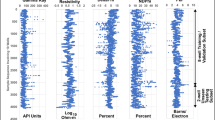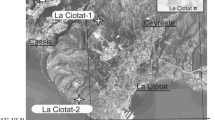Abstract
Marcellus Shale is a rapidly emerging shale-gas play in the Appalachian basin. An important component for successful shale-gas reservoir characterization is to determine lithofacies that are amenable to hydraulic fracture stimulation and contain significant organic-matter and gas concentration. Instead of using petrographic information and sedimentary structures, Marcellus Shale lithofacies are defined based on mineral composition and organic-matter richness using core and advanced pulsed neutron spectroscopy (PNS) logs, and developed artificial neural network (ANN) models to predict shale lithofacies with conventional logs across the Appalachian basin. As a multiclass classification problem, we employed decomposition technology of one-versus-the-rest in a single ANN and pairwise comparison method in a modular approach. The single ANN classifier is more suitable when the available sample number in the training dataset is small, while the modular ANN classifier performs better for larger datasets. The effectiveness of six widely used learning algorithms in training ANN (four gradient-based methods and two intelligent algorithms) is compared with results indicating that scaled conjugate gradient algorithms performs best for both single ANN and modular ANN classifiers. In place of using principal component analysis and stepwise discriminant analysis to determine inputs, eight variables based on typical approaches to petrophysical analysis of the conventional logs in unconventional reservoirs are derived. In order to reduce misclassification between widely different lithofacies (for example organic siliceous shale and gray mudstone), the error efficiency matrix (ERRE) is introduced to ANN during training and classification stage. The predicted shale lithofacies provides an opportunity to build a three-dimensional shale lithofacies model in sedimentary basins using an abundance of conventional wireline logs. Combined with reservoir pressure, maturity and natural fracture system, the three-dimensional shale lithofacies model is helpful for designing strategies for horizontal drilling and hydraulic fracture stimulation.




















Similar content being viewed by others
References
Al-Anazi A, Gates ID (2010) A support vector machine algorithm to classify lithofacies and model permeability in heterogeneous reservoirs. Eng Geol 114(3–4):267–277
Allwein EL, Schapire RE, Singer Y (2000) Reducing multiclass to binary: a unifying approach for margin classifiers. J Mach Learn Res 1:113–141
Beers RF (1945) Radioactivity and organic content of some Paleozoic shales. Am Assoc Pet Geol Bull 29(1):1–22
Blockeel H, Bruynooghe M, Dzeroski S, Ramon J, Struyf J (2002) Hierarchical multi-classification. In: Proceedings of the first international workshop on multi-relational data mining, pp 1–15
Bohling GC, Dubois MK (2003) An integrated application of neural network and Markov chain techniques to prediction of lithofacies from well logs. Kansas geological survey open-file report, no. 2003-50, 6 pp
Boyce ML, Carr TR (2010) Stratigraphy and petrophysics of the Middle Devonian black shale interval in West Virginia and Southwest Pennsylvania. Search and discovery article #10265
Bowker KA (2007) Barnett Shale gas production, Fort Worth Basin: issues and discussion. AAPG Bull 91(4):523–533
Chang HC, Kopaska-Merkel DC, Chen HC (2002) Identification of lithofacies using Kohonen self-organizing maps. Comput Geosci 28(2):223–229
Chang HC, Kopaska-Merkel DC, Chen HC, Durrans SR (2000) Lithofacies identification using multiple adaptive resonance theory neural networks and group decision expert system. Comput Geosci 26(5):591–601
Dietterich TG, Bakiri G (1995) Solving multiclass learning problems via error-correcting output codes. J Artif Intell Res 2:263–286
Doveton JH (1994) Geological log interpretation. SEPM short course, vol 29, 186 pp
Dubois MK, Bohling GC, Chakrabarti S (2007) Comparison of four approaches to a rock facies classification problem. Comput Geosci 33(2007):599–617
El-Sebakhy EA, Asparouhov O, Abdulraheem A, Wu D, Latinski K, Spries W (2010) Data mining in identifying carbonate lithofacies from well logs based from extreme learning and support vector machines. In: Proceeding of AAPG GEO 2010 Middle East geoscience conference & exhibition, pp 1–17
Engelder T (2009) Marcellus 2008: report card on the breakout year for gas production in the Appalachian Basin. Fort Worth Basin Oil and Gas Magazine 2009:20
Fertl WH, Chilingar GV (1988) Total organic carbon content determined from well logs. SPE Form Eval 15612:407–419
Hastie T, Tibshirani R (1998) Classification by pairwise coupling. Ann Stat 26(2):451–471
Haykin SS (1999) Neural network: a comprehensive foundation. Macmillan Co, New York, 842 pp
Hickey JJ, Henk B (2007) Lithofacies summary of the Mississippian Barnett Shale, Mitchell 2 T.P. Sims well, Wise County, Texas. Am Assoc Pet Geol Bull 91(4):437–443
Jacobi D, Gladkikh M, LeCompte B, Hursan G, Mendez F, Longo J, Ong S, Bratovich M, Patton G, Hughes B, Shoemaker P (2008) Integrated petrophysical evaluation of shale gas reservoirs. SPE paper no 114925, pp 1–23
Jarvie DM, Hill RJ, Ruble TR, Pollastro RM (2007) Unconventional shale-gas systems: the Mississippian Barnett Shale of North-Central Texas as one model for thermogenic shale-gas assessment. AAPG Bull 91(4):475–499
Jungmann M, Kopal M, Clauser C, Berlage T (2011) Multi-class supervised classification of electrical borehole wall images using texture features. Comput Geosci 37(2011):541–553
Koesoemadinata A, El-Kaseeh G, Banik N, Dai JC, Egan M, Gonzalez A, Tamulonis K (2011) Seismic reservoir characterization in Marcellus shale. In: Proceedings SEG San Antonio 2011 annual meeting, pp 3700–3704
Kordon AK (2010) Applying computational intelligence: how to create value. The Dow Chemical Company, Freeport, 459 pp
Li T, Zhu SH, Ogihara M (2003) Using discriminant analysis for multi-class classification: an experimental investigation. In: Proceedings of the third IEEE international conference on data mining, pp 589–592
Loucks RG, Ruppel SC (2007) Mississippian Barnett Shale: lithofacies and depositional setting of a deep-water shale-gas succession in the Fort Worth Basin, Texas. AAPG Bull 91(4):579–601
Lüning S, Kolonic S (2003) Uranium special gamma-ray response as a proxy for organic richness in black shales: applicability an limitations. J Pet Geol 26(2):153–174
Ma YZ (2011) Lithofacies clustering using principal component analysis and neural network: application to wireline logs. Math Geosci 43:401–419
Micheli-Tzanakou E (2000) Supervised and unsupervised pattern recognition: feature extraction and computational intelligence. CRC Press, Boca Raton, 371 pp
Ou GB, Murphey YL (2007) Multi-class pattern classification using neural networks. Pattern Recognit 40(1):4–18
Papazis PK (2005) Petrographic characterization of the Barnett Shale, Fort Worth Basin, Texas. M.Sc. thesis, University of Texas at Austin, Texas, 284 pp
Perez R (2009) Quantitative petrophysical characterization of the Barnett Shale in Newark east field, Fort Worth basin. M.Sc. thesis, University of Oklahoma, Norman, Oklahoma, 132 pp
Qi LS, Carr TR (2006) Neural network prediction of carbonate lithofacies from well logs, Big Bow and Sand Arroyo Creek fields, Southwest Kansas. Comput Geosci 32(7):947–964
Rider MH (1996) The geological interpretation of well logs, 2nd edn. Whittles Publishing, Caithness, Scotland, 280 pp
Saggaf MM, Nebrija EL (2003) A fuzzy logic approach for the estimation of facies from wire-line logs. AAPG Bull 87(7):1223–1240
Schmoker JW (1981) Determination of organic-matter content of Appalachian Devonian shales from gamma-ray logs. AAPG Bull 65:1285–1298
Shier DE (2004) Well log normalization: methods and guidelines. Petrophysics 45(3):268–280
Sierra R, Tran MH, Abousleiman YN, Slatt RM (2010) Woodford Shale mechanical properties and the impacts of lithofacies. In: Proceedings symposium on the 44th U.S. rock mechanics symposium and 5th U.S.–Canada rock mechanics symposium, Salt Lake City, Utah, pp 1–10
Singh P (2008) Lithofacies and sequence stratigraphic framework of the Barnett Shale, Northeastern Texas. Ph.D. dissertation, University of Oklahoma, Norman, Oklahoma, 181 pp
Swanson VE (1960) Oil yield and uranium content of black shales. USGS professional paper 356-A, pp 1–44
Teichert C (1958) Concepts of facies. AAPG Bull 42(11):2718–2744
Vallejo JS (2010) Prediction of lithofacies in the thinly bedded Barnett Shale, using probabilistic methods and clustering analysis through GAMLS TM (Geologic Analysis Via Maximum Likelihood System). M.Sc. thesis, University of Oklahoma, Norman, Oklahoma, 184 pp
Walker-Milani ME (2011) Outcrop lithostratigraphy and petrophysics of the Middle Devonian Marcellus Shale in West Virginia and adjacent states. M.Sc. thesis, West Virginia University, Morgantown, West Virginia, 130 pp
Wang G, Carr TR (2012) Black shale lithofacies identification and distribution model of Middle Devonian Intervals in the Appalachian Basin. Search and discovery article #90142
Yang YL, Aplin AC, Larter S (2004) Quantitative assessment of mudstone lithology using geophysical wireline logs and artificial neural networks. Pet Geosci 10:141–151
Acknowledgements
This research was supported by the U.S. Department of Energy National Energy Technology Laboratory’s Regional University Alliance (NETL-RUA) under the contract RES1000023/155 (Activity 4.605.920.007) and National Natural Science Foundation of China (No. 698796867). Special thanks to Energy Corporation of America, Consol Energy, EQT Production and Petroleum Develop Corporation for providing core and log data.
Author information
Authors and Affiliations
Corresponding author
Rights and permissions
About this article
Cite this article
Wang, G., Carr, T.R. Marcellus Shale Lithofacies Prediction by Multiclass Neural Network Classification in the Appalachian Basin. Math Geosci 44, 975–1004 (2012). https://doi.org/10.1007/s11004-012-9421-6
Received:
Accepted:
Published:
Issue Date:
DOI: https://doi.org/10.1007/s11004-012-9421-6




